Seoul Metropolitan Subway rolling stock

There are many types of trains in Seoul but they are usually similar to each other. Typically, train cars have four doors on each side. In between the doors are rows of either cushioned or non-cushioned seats for 7 people, except for the outer ends of each wagon where there are smaller rows of seats for 3 people, marked for the use by the elderly, disabled passengers, and pregnant women.
This list focuses primarily on trains that run on the 9 urban subway lines in Seoul, the wide-area commuter rail lines integrated into the Seoul Metropolitan Subway, and the AREX airport railroad. The list does not, however, include rolling stock used on the Incheon Subway and light metro systems such as the U Line or EverLine.
Features
Emergency procedures

Each train has at least one fire extinguisher and options for opening the door in an emergency. A SOS phone is placed in most cars operated by the Seoul Metropolitan Rapid Transit Corporation, and all new rolling stock.
Help for English Speakers

All trains in Seoul have both English and Korean announcements regarding each train stop. In addition, a map displays their names in both Korean and English characters. Many trains also have a LED display above a door or in the middle of the train car that displays information in Korean and English, though many side signs have been removed from trains due to their reduced visibility with the advent of platform screen doors. Some of the newest trains feature LCD screens above the doors or the middle of the train that display short commercials and station information.
Trains
Seoul Metro & Korail
Active
All trains are 19.6 meters in length, 3.12 meters in width, and 3.8 meters in height. Newer trains operated by Seoul Metro are usually given the same number as the trains they are intended to replace.
| Series | Operator | Year built and builder |
Photo | Numbers & total ordered | Control | Assigned Services | Yard assignment |
Notes |
|---|---|---|---|---|---|---|---|---|
| Seoul Metro 1000-series (first generation, newer cars) |
Seoul Metro | 1989 (rebuilt 1999 & 2002) Daewoo Heavy Industries, Hyundai Precision & Industries Corporation, Rotem |
 |
Trains 11-16 (6 trains, 60 cars) | Rheostat | |
Gunja |
|
| Seoul Metro 2000-series (first generation, second batch) |
Seoul Metro | 1989-1990 Hyundai Precision & Industries Corporation, Hanjin Heavy Industries |
 |
Trains 06-13, 41-44 (12 trains) | Chopper | |
Sinjeong |
|
| Seoul Metro 2000-series wide-width Seoul Metro 3000-series (second batch) |
Seoul Metro | 1990-1993 Daewoo Heavy Industries |
 _arriving_at_Oksu.jpg) _leaving_Oksu.jpg) |
Line 2 trains 78-92 Line 3 trains 16-20, 34-35, 41-48 (30 trains) |
|
Line 2: Gunja Line 3: Jichuk (16-20) Suseo (34-35, 41-48) |
| |
| Seoul Metro 2000-series (first generation, newer cars) |
Seoul Metro | 1991-1993 (rebuilt 2007-2009) Daewoo Heavy Industries, Hyundai Precision & Industries Corporation, Hanjin Heavy Industries |
_leaving_Konkuk_Univ.jpg) |
Trains 32-39, 73-77 (13 trains) | |
Sinjeong (trains 32-39) Gunja (trains 73-77) |
| |
| Korail 1000-series (second generation) |
Korail | 1991-1992 Daewoo Heavy Industries, Hyundai Precision & Industries Corporation, Hanjin Heavy Industries |
_leaving_Noryangjin.jpg) |
Trains 64, 72-73 (3 trains, 30 cars) | Rheostat | |
Guro |
|
| Seoul Metro 2000-series (first generation, newer cars, rheostat) |
Seoul Metro | 1993 (rebuilt 2005) Hanjin Heavy Industries |
 |
Trains 45-48, 56 (5 trains) | Rheostat | |
Sinjeong (45-48) Gunja (56) |
|
| Seoul Metro 2000-series (second generation) |
Seoul Metro | 1993-1994 Daewoo Heavy Industries, Hyundai Precision & Industries Corporation, Hanjin Heavy Industries |
 |
Trains 14, 93-95 (4 trains) | Chopper | |
Sinjeong (train 14) Gunja (trains 93-95) |
*Train 14 (ex 2-53) was built in 1993 and uses MELCO propulsion systems, while trains 93-95 were built in 1994 and use GEC propulsion systems. |
| Seoul Metro 4000-series | Seoul Metro | 1993-1994 Hyundai Precision & Industries Corporation (1st batch), Daewoo Heavy Industries (2nd batch) |
 |
Trains 01-26, 51-71 (47 trains) | VVVF inverter | |
Chang-dong |
|
| Korail Class 341000 (first generation) |
Korail | 1993-1996 Daewoo Heavy Industries, Hyundai Precision & Industries Corporation, Hanjin Heavy Industries |
 |
Trains 01-25 (25 trains) | |
Ansan, Siheung | Formerly numbered as trains 2-30~2-46, 2-49, 2-51~2-64, and 2-70~2-72. | |
| Korail Class 351000 (first generation) |
Korail | 1993, 1996, 1999 Daewoo Heavy Industries, Hyundai Precision & Industries Corporation |
 |
Trains 351-01~351-22 (22 trains) | Bundang | Bundang | Formerly numbered as trains 2-47~2-48, 2-50, 2-55~2-69, and 2-73~2-76. | |
| Korail Class 1000 (third generation) |
Korail | 1994-1997 Daewoo Heavy Industries, Hyundai Precision & Industries Corporation, Hanjin Heavy Industries |
 |
Trains 74-81, 83-86 (11 trains) | Rheostatic | |
Guro |
|
| Korail Class 3000 | Korail | 1995-1997 Hyundai Precision & Industries Corporation |
 |
Trains 71-86 (16 trains) | VVVF inverter | |
Jichuk | |
| Korail Class 311000 (first generation) |
Korail | 1996-1998 Daewoo Heavy Industries, Hyundai Precision & Industries Corporation |
 |
Trains 01-41 (41 trains) | |
Guro, Imun |
| |
| Seoul Metro 1000-series (second generation) |
Seoul Metro | 1998-1999, 2002 Hyundai Precision & Industries Corporation (1st batch), Rotem (2nd batch) |
 |
Trains 01-10 (10 trains) | |
Gunja |
| |
| Korail Class 341000 (second generation) |
Korail | 1999 KOROS |
 |
Trains 26-30 (5 trains) | |
Ansan, Siheung | Formerly numbered as trains 2-77~2-81. | |
| Korail Class 311000 (second generation) |
Korail | 2002-2004 Daewoo Heavy Industries, Hyundai Precision & Industries Corporation |
 |
Trains 42-65 (24 trains) | |
Guro, Byeongjeom |
| |
| Korail Class 351000 (second generation) |
Korail | 2003 Rotem |
 |
Trains 351-23~351-28 (6 trains) | Bundang | Bundang | Formerly numbered as trains 2-82~2-87 | |
| Seoul Metro 2000-series (third generation, first batch) |
Seoul Metro | 2005 Hyundai Rotem |
 |
Trains 01-05, 57 (6 trains) | |
Sinjeong (01-05), Gunja (57) |
| |
| Korail Class 311000 (third generation, first batch) |
Korail | 2005-2006 Rotem |
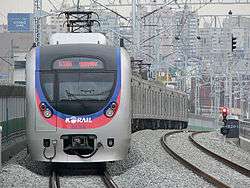  |
Trains 66-82 (17 trains) | |
Guro, Byeongjeom, Imun |
| |
| Korail Class 319000 | Korail | 2006/1997 Hyundai Rotem (rebuilder) |
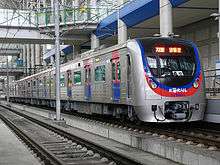 |
Trains 01-07 (7 trains) | |
Guro |
| |
| Seoul Metro 2000-series (third generation, second batch) | Seoul Metro | 2007-2008 Hyundai Rotem |
_arriving_at_Konkuk_Univ.jpg) |
Trains 15-31, 58-72 (32 trains) | |
Sinjeong (15-31) Gunja (58-72) |
| |
| Korail Class 321000 | Korail | 2006, 2008-2009 Rotem, Hyundai Rotem |
 |
Trains 01-21 (21 trains) | Gyeongui–Jungang | Yongmun |
| |
| Korail Class 331000 (first generation) |
Korail | 2009 Hyundai Rotem |
 |
Trains 01-13 (13 trains) | Gyeongui–Jungang | Munsan | ||
| Seoul Metro 3000-series (second generation) |
Seoul Metro | 2009-2010 Hyundai Rotem |
 |
Trains 01-33, 36-40, 49 (39 trains) | |
Jichuk (01-15) Suseo (21-33, 36-40, 49) |
||
| Korail Class 361000 | Korail | 2010 Hyundai Rotem |
 |
Trains 01-13 (13 trains) | Gyeongchun | Pyeongnae |
| |
| Korail Class 351000 (third generation) |
Korail | 2011-2014 Hyundai Rotem |
 |
Trains 29-43, 61-72 (27 trains) | Bundang Suin |
Bundang (29-43) Siheung (61-72) |
| |
| Korail Class 331000 (second generation) |
Korail | 2012-2014 Hyundai Rotem |
 |
Trains 14-27 (14 trains) | Gyeongui–Jungang | Munsan |
| |
| Korail Class 311000/312000 (third generation, second batch) |
Korail | 2012-2014 Hyundai Rotem |
|
Trains 83-94 (12 trains); more trains TBD | |
Guro |
| |
| Korail Class 311000/312000 (third generation, third batch) |
Korail | 2016 Hyundai Rotem |
 |
Trains 95-99 (5 trains) |
| |||
| Korail Class 371000 |  |
Trains 1-12 (12 trains) | Gyeonggang Line | Bubal | ||||
Retired
| Model & series number | Operator | Year built and builder |
Photo | Numbers & total ordered | Control | Assigned Services | Year(s) retired | Notes |
|---|---|---|---|---|---|---|---|---|
| Seoul Metro 1000-series (first generation) |
Seoul Metro | 1974, 1977-1978 Daewoo Heavy Industries, Hitachi |
 |
Trains 01/02-31/32 (16 trains) | Rheostat | |
1998-1999, 2002 |
|
| Korail Class 1000 (first generation) |
Korail | 1974-1977 Daewoo Heavy Industries, Hyundai Precision & Industries Corporation, |
 |
Trains 01-41 (41 trains) | |
1999-2004 (original cars) 2006 (un-overhauled newer cars) 2012-2014 (overhauled newer cars) |
| |
| Seoul Metro 2000-series (first generation, rheostat) |
Seoul Metro | 1980-1982 Hyundai Precision & Industries Corporation, Hanjin Heavy Industries, Nippon Sharyo |
Trains 01-14 (see notes) (14 trains) | |
2005, 2007 |
| ||
| Seoul Metro 2000-series (first generation, first batch, chopper) |
Seoul Metro | 1983-1984 Daewoo Heavy Industries, Hyundai Precision & Industries Corporation, Hanjin Heavy Industries |
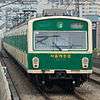 |
Trains 15-39, 61-75 (40 trains) | Chopper | |
2007-2008 |
|
| Seoul Metro 2000-series/3000-series (GEC chopper, wide-width first generation) |
Seoul Metro | 1984-1985 Daewoo Heavy Industries |
 |
Line 2 trains 76-77 Line 3 trains 01-15, 21-33, 36-40 (36 trains) |
|
2009-2010 |
| |
| Korail Class 1000 (second generation) |
Korail | 1986-1989, 1991 Daewoo Heavy Industries, Hyundai Precision & Industries Corporation, Hanjin Heavy Industries |
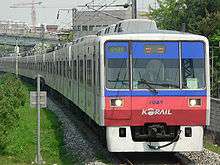 _OC.jpg) |
Trains 42-63, 65-71, 82, 87 (32 trains) | Rheostat | |
2001 2006 2012- |
|
SMRT
All SMRT trains are equipped with an ATO (Automatic Train Operation) system. However, there is always a driver on board in case of failure of the ATO system. Second batched trains use VVVF inverters, while first batch uses ABB-GTO
Line 5
- SMRT 5000-series
- 1st batch (trains 5-01~5-46), manufactured 1994-1995 by Hyundai Precision
- 2nd batch (trains 5-47~5-76), manufactured 1996-1997 by Hyundai Precision
Line 6
- SMRT 6000-series (trains 6-01~6-41), manufactured 1999-2000 Hyundai Precision
- Train 6-05 is currently assigned to Line 7.
Line 7
- SMRT 7000/8000-series
- 1st generation (trains 7-01~7-17), manufactured 1995-1997 by Daewoo Heavy Industries
- 2nd generation (trains 7-18~7-63), manufactured 1999-2000
- SMRT SR trains (trains 7-64~7-70), manufactured 2011-2012 by Hyundai Rotem
Line 8
- SMRT 7000/8000-series
- 1st generation (trains 8-01~8-15), manufactured 1995-1996 by Daewoo Heavy Industries
- 2nd generation (trains 8-16~8-20), manufactured 1999
- Former trains 8-21~8-22 were used to create newer cars for train 7-51 and to create train 7-63. One car was repurposed into a mockup of the SR train.
 5000-series EMU for Line 5
5000-series EMU for Line 5 6000-series EMU for Line 6
6000-series EMU for Line 6 7000-series VVVF EMU for Line 7
7000-series VVVF EMU for Line 7 SR EMU for Line 7
SR EMU for Line 7 8000-series VVVF EMU for Line 8
8000-series VVVF EMU for Line 8
Seoul Metro Line 9 Corporation (Metro 9)
Seoul Metro (Line 9 Corporation) 9000-series
- First batch (2008) - trains 01-24
- Second batch (2011) - trains 25-36
- Third batch (2016) - trains 37-44
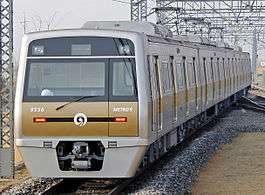 9000-series EMU for Line 9
9000-series EMU for Line 9
NeoTrans Co. Ltd.
- Sin Bundang Line - D000 series
- VVVF inverter controlled electric car (20 trains)
- These trains are all ATO operated, which means that it is controlled by a computer system on board the train (Driverless operation), manufactured by Hyundai Rotem.[2][3]
 D000 series VVVF inverter controlled EMU
D000 series VVVF inverter controlled EMU
Korail Airport Railroad Co., Ltd.
- AREX 1000 series
- VVVF inverter controlled electric car
- AREX 2000 series
- VVVF inverter controlled electric car
 AREX 1000 series
AREX 1000 series AREX 2000 series
AREX 2000 series
See also
- Korail
- Seoul Metropolitan Subway
- Seoul Metro
- Seoul Metropolitan Rapid Transit Corporation
- Seoul Metro Line 9 Corporation
References
- 1 2 https://www.youtube.com/watch?v=F4ZMrU51fnc
- ↑ "EMUs". Hyundai Rotem. Retrieved 2014-07-29.
- ↑ "Railway System". Hyundai Rotem. Retrieved 2014-07-29.